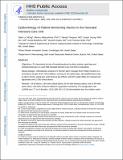| dc.contributor.author | Matsushima, Minoru | |
| dc.contributor.author | Timpson, Wendy | |
| dc.contributor.author | Young, Susan | |
| dc.contributor.author | Miedema, David | |
| dc.contributor.author | Gupta, Munish | |
| dc.contributor.author | Li, Taibo,M. Eng.Massachusetts Institute of Technology. | |
| dc.date.accessioned | 2019-06-24T14:38:33Z | |
| dc.date.available | 2019-06-24T14:38:33Z | |
| dc.date.issued | 2018-05 | |
| dc.identifier.issn | 0743-8346 | |
| dc.identifier.uri | https://hdl.handle.net/1721.1/121389 | |
| dc.description.abstract | Objective: To characterize the rate of monitoring alarms by alarm priority, signal type, and developmental age in a Level-IIIB Neonatal Intensive Care Unit (NICU) population. Study design: Retrospective analysis of 2,294,687 alarm messages from Philips monitors in a convenience sample of 917 NICU patients, covering 12,001 patient-days. We stratified alarm rates by alarm priority, signal type, postmenstrual age (PMA) and birth weight (BW), and reviewed and adjudicated over 21,000 critical alarms. Results: Of all alarms, 3.6% were critical alarms, 55.0% were advisory alarms, and 41.4% were device alerts. Over 60% of alarms related to oxygenation monitoring. The average alarm rate (±SEM) was 177.1 ± 4.9 [median: 135.9; IQR: 89.2–213.3] alarms/patient-day; the medians varied significantly with PMA and BW (p < 0.001) in U-shaped patterns, with higher rates at lower and higher PMA and BW. Based on waveform reviews, over 99% of critical arrhythmia alarms were deemed technically false. Conclusions: The alarm burden in this NICU population is very significant; the average alarm rate significantly underrepresents alarm rates at low and high PMA and BW. Virtually all critical arrhythmia alarms were artifactual. | en_US |
| dc.description.sponsorship | Nihon Kohden Corporation | en_US |
| dc.description.sponsorship | Nihon Kohden Innovation Center | en_US |
| dc.description.sponsorship | Massachusetts Institute of Technology (Peter J. Eloranta Summer Undergraduate Research Fellowship) | en_US |
| dc.description.sponsorship | Massachusetts Institute of Technology (Wertheimer Undergraduate Research and Innovation Scholar Fund) | en_US |
| dc.language.iso | en | |
| dc.publisher | Springer Nature | en_US |
| dc.relation.isversionof | http://dx.doi.org/10.1038/S41372-018-0095-X | en_US |
| dc.rights | Article is made available in accordance with the publisher's policy and may be subject to US copyright law. Please refer to the publisher's site for terms of use. | en_US |
| dc.source | PMC | en_US |
| dc.title | Epidemiology of patient monitoring alarms in the neonatal intensive care unit | en_US |
| dc.type | Article | en_US |
| dc.identifier.citation | Li, Taibo, et al. “Epidemiology of Patient Monitoring Alarms in the Neonatal Intensive Care Unit.” Journal of Perinatology, 38, 8 (August 2018): 1030–38. | en_US |
| dc.contributor.department | Massachusetts Institute of Technology. Institute for Medical Engineering & Science | en_US |
| dc.relation.journal | Journal of Perinatology | en_US |
| dc.eprint.version | Author's final manuscript | en_US |
| dc.type.uri | http://purl.org/eprint/type/JournalArticle | en_US |
| eprint.status | http://purl.org/eprint/status/PeerReviewed | en_US |
| dc.date.updated | 2019-05-30T18:40:20Z | |
| dspace.date.submission | 2019-05-30T18:40:21Z | |
